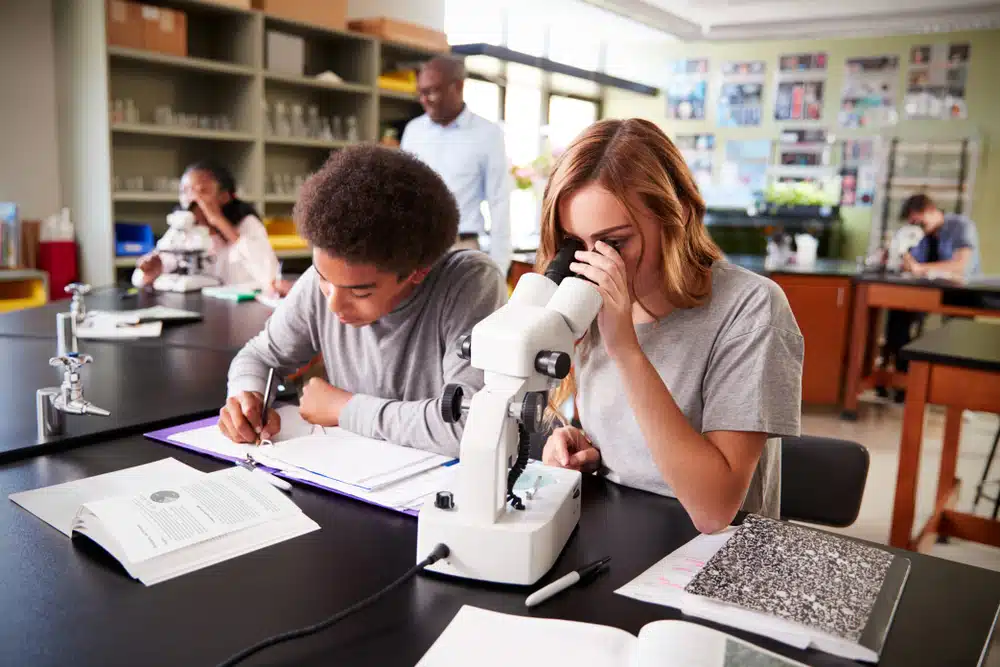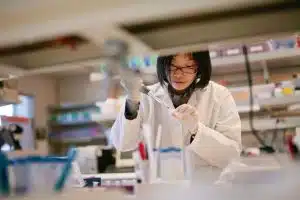30 Research Ideas in Biology for High School Students
High school students often discover that engaging with research ideas in biology significantly enhances their learning experience. Biology, studying life and living organisms, offers many opportunities for curiosity-driven projects.
This blog is dedicated to igniting a passion for scientific discovery for high school students by showcasing 30 research ideas in biology.
These topics are intended as more than just academic tasks; they serve as openings into the fascinating world of biology, enabling students to contribute to our understanding of life.
30 Research Ideas in Biology for High School Students
Exploring biology offers high school students a fascinating journey into the study of life. This field touches everything from the tiny genes that make us who we are to the vast ecosystems that sustain life on Earth.
Here are 30 research ideas for high school students to stimulate inquiry and enhance their understanding of biological principles.
1. Genetics and Heredity: Understanding Life’s Blueprint
Genetics and heredity are the foundation of life’s diversity. High school students can explore how DNA acts as life’s blueprint through simple experiments like DNA extraction from fruits or studying genetic traits and inheritance patterns.
Projects could involve investigating genetic disorders or examining Mendel’s principles through pea-plant experiments.
This area helps students grasp how traits are inherited and the importance of genetics in health while also considering the ethical aspects of genetic engineering.
2. Microbiology: Tackling Antibiotic Resistance
Antibiotic resistance is a critical challenge in microbiology, impacting global health. Students can study this by examining how bacteria grow and respond to antibiotics, showcasing natural selection and mutation.
Projects may include testing the effectiveness of various antibiotics on bacteria and demonstrating how these microorganisms evolve to resist treatment.
This research highlights the need for responsible antibiotic use and the search for new treatments, connecting students to a pressing real-world issue.
3. Botany: The Role of Soil in Plant Growth
The type of soil is crucial for plant health and agricultural output. Students can investigate plant growth in different soils—clay, loam, sand, silt—or analyze the impact of soil pH and nutrients.
By measuring plant growth indicators under varied conditions, this research underscores the importance of soil management for sustainability and food security. It offers a practical look into botany and ecology, with implications for environmental care and agricultural practices.
4. Zoology: Understanding Local Wildlife Behavior for Conservation
Exploring research ideas in biology for high school students can begin right in their backyard by studying local wildlife behavior. This research idea allows high school students to observe wildlife, noting their feeding, social habits, and how they adapt to seasons or changes in their habitat.
This work is crucial for conservation, as understanding animal behavior can help protect them, especially as their environments change due to human actions.
Simple tasks like tracking animal movements or using basic technology to monitor them can offer insights into how to keep local species thriving.
5. Ecology: The Effects of Human Actions on Local Ecosystems
This project focuses on how our activities impact nearby nature. Students can look at local environmental issues, such as pollution or land development, and see how these affect plants and animals.
By collecting soil, water, and air samples or counting the types of species in an area, students can get a clear picture of human impact.
This teaches important ecological concepts and shows students how they can help preserve the environment.
6. Biotechnology: CRISPR and Its Role in Changing Genes
CRISPR technology is a groundbreaking tool in biology that allows scientists to edit genes with precision. This research idea introduces students to the forefront of genetic engineering, showing them how CRISPR can be used in medicine, agriculture, and more.
Students can learn about how CRISPR works and discuss its significant potential and ethical considerations.
Students get a well-rounded view of modern biotechnology by exploring real-world applications and engaging in debates about the moral aspects of gene editing.
7. Marine Biology: Coral Bleaching and Its Effects
Marine biology is a key area for high school research, especially looking into coral bleaching and its impact on ocean life. Coral reefs are crucial for marine ecosystems, acting as homes and food sources for many sea creatures.
However, they’re very sensitive to temperature changes. Global warming has caused more frequent coral bleaching, where corals lose their vibrant colors and main food source due to stress.
This research topic is vital for understanding how coral bleaching affects marine biodiversity and the health of our oceans. It’s a chance for students to contribute to marine conservation efforts and highlight the importance of tackling climate change.
8. Neurobiology: Brain Plasticity and Learning
Exploring research ideas in biology for high school students, neurobiology presents an engaging field, particularly its focus on brain plasticity and its implications for learning and rehabilitation. Brain plasticity is the brain’s ability to change and adapt by forming new connections.
This is crucial for learning new skills, healing after brain injuries, and adjusting to changes. Research could examine how learning activities, like playing an instrument or a new language, influence the brain and improve cognitive functions.
This topic sheds light on how education and therapy can boost brain recovery and enhance learning abilities, showing the power of our brains to adapt and grow.
9. Immunology: How Vaccines Work
Given current global health issues, immunology, especially understanding vaccines, is a timely research topic. Vaccines teach the immune system to fight off diseases without getting sick.
Research in this area can explore the various types of vaccines, how they are developed, and their role in public health, such as stopping smallpox and controlling polio.
This topic is crucial for promoting informed discussions on vaccine development, effectiveness, safety, and the importance of vaccinations in protecting global health.
10. Environmental Science: Impact of Plastic Pollution on Aquatic Life
Plastic pollution is a major problem for water environments, hurting sea animals and ecosystems. High school students can explore how plastics harm fish, marine mammals, and other sea life. This project could include:
- Understanding Plastic Pollution: Learn how plastic ends in oceans and lakes and its journey through these waters.
- Case Studies: Pick a local water body to study the effects of plastic pollution on sea life, like how fish eat microplastics or turtles get tangled in plastic waste.
- Effects on Sea Life: Look into how plastics harm sea animals, causing problems like less mobility, reproductive issues, and even death. See how plastics carry other pollutants, making things worse.
- Solutions: End your project by suggesting ways to lessen plastic pollution, like community clean-ups, better waste management, or using less plastic.
11. Molecular Biology: Protein Synthesis Process
Protein synthesis is crucial for life, turning genetic information into proteins that cells need to function. High school students can explore this process through activities like:
- The Basics: Start with the flow of genetic information from DNA to RNA to protein, focusing on transcription (making mRNA from DNA) and translation (making proteins from mRNA).
- Experiments: Try experiments with simple organisms to see how different conditions affect protein synthesis, such as changes in temperature or chemicals.
- Genetic Engineering: Discuss how understanding protein synthesis helps make medicines and vaccines, and discuss the debates around GMOs.
- Careers: Look into molecular biology and genetic engineering jobs, showing future possibilities.
12. Evolutionary Biology: Natural Selection
Natural selection explains how living things adapt to their environment. High school students can observe evolution through various methods:
- Computer Simulations: Use software to simulate natural selection under different conditions, changing factors like mutation rates or environmental changes to see how populations evolve.
- Field Work: Observe local wildlife over time to see natural selection, noting how certain traits become more common because they help survival.
- Case Studies: Study well-known examples of natural selection, such as the peppered moth or antibiotic-resistant bacteria, to understand how these changes happen.
- Debates: Discuss natural selection’s role in evolution, addressing misconceptions and examining evidence that supports this theory.
13. Conservation Biology: Protecting Endangered Species
Conservation Biology is crucial for maintaining biodiversity and safeguarding species at risk of extinction. High school students seeking research ideas in biology can engage in projects to preserve wildlife and their habitats in this field.
Research could involve identifying endangered species in local areas, evaluating their living conditions, and suggesting ways to protect them.
This might include studying the effects of human actions on these species and proposing solutions to reduce negative impacts.
Such projects educate students about preserving biodiversity and empower them to advocate for environmental protection.
14. Biochemistry: The Basics of Fermentation
Biochemistry connects biology with chemistry by examining the chemical processes in living organisms. A compelling project topic in this area is the study of fermentation, a process where enzymes break down substances into simpler products.
This is key in making foods and drinks like bread, cheese, yogurt, and beer. Students can explore how fermentation works, what factors influence its efficiency, and the role of different microbes in this process.
Through these projects, students will learn about the practical applications of biochemistry in everyday life and gain valuable hands-on experience.
15. Astrobiology: Life in Extreme Conditions
Astrobiology explores the possibility of life in the universe, starting with life forms on Earth that survive in extreme conditions. Research projects can focus on extremophiles, organisms that live in harsh environments, such as very hot or acidic places.
Students can investigate how these organisms adapt and what this means for the existence of life beyond Earth. This research could include collecting samples from extreme environments and analyzing how these organisms survive.
Such studies broaden our understanding of life’s diversity on Earth and inspire curiosity about life in the wider universe.
16. Pharmacology: Natural vs. Synthetic Medicines and Their Impact on Health
When exploring research ideas in biology for high school students, a fascinating topic is comparing natural and synthetic medicines.
This research can shed light on which type of medicine provides better health benefits, has fewer side effects, and is more cost-effective. Students can:
- Study Effectiveness: Look into how well natural and synthetic medicines treat diseases.
- Check Safety: Compare both medicine types’ side effects and safety.
- Analyze Costs: See which medicines are more affordable and easier to get.
- Understand Preferences: Find out why some people prefer natural or synthetic medicines, including cultural reasons.
This project can help understand the best treatment options, blending science with real-world health choices.
17. Anatomy and Physiology: How Exercise Influences Our Bodies
Another excellent topic among research ideas in biology for high school students involves studying how exercise affects our bodies, which is crucial for health and fitness. This research can:
- Examine the Heart: Look at how exercises like running impact heart health.
- Study Muscles and Bones: Investigate how lifting weights affects muscle size and bone health.
- Look at Metabolism: Explore how exercise changes how our bodies use sugar and fat.
- Explore Brain Health: Find out how being active benefits our brains, mood, and thinking.
This research highlights the importance of exercise in maintaining a healthy body and mind.
18. Cell Biology: Understanding Mitosis and Meiosis
In cell biology, mitosis and meiosis are central to life. These processes are essential for growth, healing, and reproduction. High school students can study:
- Processes: Outline the steps of mitosis and meiosis, noting key differences.
- Genetic Diversity: Explore how meiosis creates different genetic combinations.
- Regulation: Study how cells control these processes and why it’s important.
- Errors and Consequences: Investigate what happens when these processes go wrong, like cancer from mitosis errors or genetic issues from meiosis mistakes.
19. Biophysics: Understanding Muscle Movement
Biophysics combines biology and physics to explore life’s physical principles. A captivating project for high school students is examining muscle movement.
This topic investigates how muscles turn chemical energy into motion, focusing on muscle types, energy use, and how temperature affects performance.
Such a study enhances understanding of human body functions and shows how physics applies to biological systems, emphasizing the value of cross-disciplinary study.
20. Paleontology: Discovering Ancient Life through Fossils
Paleontology uses fossils to study ancient life, offering insights into Earth’s historical changes. High school students can create projects identifying and analyzing fossils to learn about past environments and life forms.
Activities might include visiting fossil sites or museums and conducting lab analyses to age and classify fossils.
This research links biology with Earth’s history, fostering appreciation for life’s complexity and developing scientific investigation and analysis skills.
21. Bioinformatics: Analyzing Biological Data with Computer Science
Bioinformatics is at biology’s forefront, using technology to manage and interpret complex data. For students interested in biology and tech, bioinformatics projects offer a chance to study gene analysis, protein structures, or genetic diversity.
This field involves coding, data management, and visualization, contributing to disease research, evolution, and ecosystems.
Bioinformatics projects prepare students for modern science careers and stress computational skills in addressing biological questions.
22. Virology: Understanding Virus Life Cycles
Virology, the study of viruses, is crucial, especially during global pandemics. Students can explore how viruses infect, replicate, and spread. Projects may focus on virus structures, immune system evasion, or vaccine impacts.
This area highlights virology’s role in public health and emphasizes the need for ongoing research to combat viral diseases effectively.
23. Agricultural Science: GMOs and Food Production
Investigating GMOs’ impact on food production is essential for addressing future food security challenges. Students can examine how GMOs have improved agriculture, from increasing yields to enhancing crop resistance to pests and diseases.
Students can assess productivity, environmental effects, and health implications by comparing GMO and organic crops, providing insights into sustainable and safe food production methods.
24. Entomology: Bees and Pollination
Studying bees’ role in pollination is critical for ecosystems and agriculture. Bees are key pollinators, supporting many food crops.
Research can focus on how environmental factors like pesticides and habitat loss affect bees and pollination.
Projects on bee conservation can also highlight the importance of biodiversity for ecosystem health and food security.
25. Ethology: Animal Behavior and Survival
Ethology looks at how animals behave and survive in their environments. High school students can explore animal behaviors, like how birds communicate or how ants organize their societies.
Students can learn about instincts and survival tactics by observing animals in nature or at home. This area offers a chance to develop observation and analysis skills, making it an engaging choice for high school students for research ideas in biology.
26. Pathology: Understanding Diseases
Pathology bridges biology and medicine by studying diseases and their effects on the body. Students can research diseases like diabetes or cancer, focusing on causes, symptoms, and impacts on organs.
Students gain insights into disease processes and the human body’s response through case studies or data analysis.
This field encourages critical thinking about health and disease prevention, positioning it as a valuable research idea in biology for high school students.
27. Toxicology: Effects of Toxins on Life
Toxicology examines how chemicals affect living organisms and the environment. Students can investigate the toxicity of household chemicals on plants or the accumulation of pollutants in wildlife, learning about the dangers of toxins and the importance of environmental protection.
Projects in toxicology can teach about chemical safety, environmental health, and sustainable practices.
It’s an important and relevant field among research ideas in biology for high school students, highlighting the link between human actions and the health of our planet.
28. Biomedical Engineering: New Medical Devices
Biomedical engineering merges medicine and engineering to create devices that improve health care. High school students looking into research ideas in biology can focus on projects like:
- Designing Health Monitors: Making wearable devices that track real-time health data.
- Improving Prosthetics: Working on prosthetic limbs that move more naturally.
- Advancing Drug Delivery: Creating smarter ways to deliver drugs to specific body parts with minimal side effects.
This research is crucial for enhancing patient care and making treatments more affordable and accessible.
29. Nutritional Science: Understanding Healthy Eating
Nutritional science examines how our diet affects our health and how to prevent diseases through food. Students can explore various topics, such as:
- Plant-based Diet Benefits: Investigating health impacts and potential gaps in plant-based diets.
- Processed Foods and Health: How processed foods affect our long-term health.
- Nutrition Education Programs: Designing projects to teach healthy eating in schools or communities.
This area of research helps inform better dietary recommendations and supports public health by promoting nutritional knowledge.
30. Developmental Biology: Growth and Development
Developmental biology studies how organisms grow from conception to adulthood. Research ideas in biology for high school students might include:
- Genetics in Development: Analyzing how certain genes affect growth.
- Regeneration Mechanisms: Studying how some animals regrow parts of their bodies and applying these insights.
- Environmental Impacts on Growth: Examining how external factors like temperature or pollution affect development.
This research deepens our understanding of life’s processes and has broad implications across medicine, environmental science, and agriculture.
By engaging in these studies, students contribute to our knowledge and may discover a passion for biological sciences.
How to Start Your Biology Research Project
Starting a biology research project is an exciting step into discovering new insights about the natural world. Here’s how to get your project off to a great start, focusing on research ideas in biology for high school students.
- Select Your Topic Carefully: Choose a topic that grabs your interest and is doable. Think about what resources you’ll need and whether you can get them through your school or local community. Talk about your ideas with a teacher or mentor for advice on shaping your project.
- Do Your Homework: Before deciding on your hypothesis, explore existing studies. Look at scientific journals, articles, and books related to your chosen topic. This step helps you understand what’s already known and pinpoint areas that need more exploration.
- Craft a Hypothesis: Your hypothesis is a prediction you aim to test. It should be specific and based on your initial research. For instance, if investigating how soil acidity impacts plant growth, you might predict that increased soil acidity reduces plant growth. This hypothesis will guide your entire project.
- Plan Your Experiment: Consider how to test your hypothesis while keeping other factors constant. Outline everything from what you’ll need and how you’ll set up your experiment to how you’ll collect and analyze data. Make sure your plan follows safety rules.
- Prepare for Data Collection and Analysis: Decide how you’ll record and analyze your findings. Choose methods that suit your project, whether using a notebook, a spreadsheet, or software. Think about the statistical techniques you’ll use for analyzing your data.
- Set a Timeline: Organize your work with a timeline that includes key milestones from start to finish. Anticipate potential hurdles and how you might overcome them.
- Get Feedback: Regularly share your progress with teachers, mentors, or classmates. They can offer valuable insights, help solve problems, and refine your approach.
- Be Flexible: Research is about learning and adapting. Be ready to revise your hypothesis or methods based on new findings. Flexibility is crucial for successful scientific research.
By following these steps, you’ll manage your project more smoothly and enjoy uncovering new knowledge.
Every big scientific achievement starts with curiosity and a well-planned approach. Your work on research ideas in biology for high school students could be the beginning of an exciting scientific journey.
The Importance of Ethical Considerations in Biological Research
Exploring research ideas in biology for high school students requires a strong ethical framework. This ensures that our investigations respect life and have a minimal environmental impact.
Ethical research is crucial for the integrity of our findings and for teaching responsibility and ethical conduct in scientific work.
Respecting Life and Protecting the Environment
Ethical biological research prioritizes the welfare of all living beings involved. Whether dealing with plants, animals, or microorganisms, it’s essential to cause the least harm possible.
This means conducting studies to avoid disrupting natural behaviors or habitats. For projects involving fieldwork, it’s particularly important to conduct research without harming the ecosystem.
Additionally, considering the environmental impact of our research is vital. Projects should aim for sustainability, avoiding actions that could harm natural habitats or contribute to pollution.
This approach ensures that pursuing knowledge does not come at the cost of environmental degradation.
Enhancing Credibility Through Ethics
Adhering to ethical guidelines enhances the reliability and respectability of scientific work. Ethical research is a testament to the pursuit of knowledge for the greater good, ensuring that findings are trustworthy and can serve as a foundation for future studies.
Teaching Responsibility and Integrity
For students investigating research ideas in biology for high school students, ethical considerations are a critical part of learning. They encourage a deep sense of responsibility towards our planet and highlight the ethical dimensions of scientific inquiry.
Students learn the importance of conducting research honestly, acknowledging the limits of their studies, and respecting others’ work.
Ethical considerations are fundamental when exploring research ideas in biology for high school students. They ensure that our search for understanding respects all life forms and the environment, enriching the scientific community with credible, responsible work.
Teaching young scientists about ethics is key to fostering a future where research is conducted with integrity and a deep respect for the natural world.
Conclusion
Exploring research ideas in biology for high school students offers a unique opportunity to explore the mysteries of the natural world. These projects enhance academic skills and foster a deeper appreciation for the complexity and interconnectivity of life on Earth.
We encourage students to pursue these research ideas with curiosity, dedication, and a sense of responsibility toward the broader implications of their work.











































